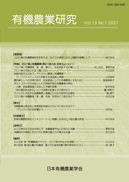Volume 13, Issue 1
Displaying 1-12 of 12 articles from this issue
- |<
- <
- 1
- >
- >|
Foreword
-
2021Volume 13Issue 1 Pages 2-3
Published: July 31, 2021
Released on J-STAGE: September 14, 2021
Download PDF (245K)
Feature
-
2021Volume 13Issue 1 Pages 4-6
Published: July 31, 2021
Released on J-STAGE: September 14, 2021
Download PDF (370K) -
2021Volume 13Issue 1 Pages 7-9
Published: July 31, 2021
Released on J-STAGE: September 14, 2021
Download PDF (313K) -
2021Volume 13Issue 1 Pages 10-13
Published: July 31, 2021
Released on J-STAGE: September 14, 2021
Download PDF (368K) -
2021Volume 13Issue 1 Pages 14-17
Published: July 31, 2021
Released on J-STAGE: September 14, 2021
Download PDF (331K) -
2021Volume 13Issue 1 Pages 18-20
Published: July 31, 2021
Released on J-STAGE: September 14, 2021
Download PDF (268K) -
2021Volume 13Issue 1 Pages 21-24
Published: July 31, 2021
Released on J-STAGE: September 14, 2021
Download PDF (366K) -
2021Volume 13Issue 1 Pages 25-27
Published: July 31, 2021
Released on J-STAGE: September 14, 2021
Download PDF (310K) -
2021Volume 13Issue 1 Pages 28-30
Published: July 31, 2021
Released on J-STAGE: September 14, 2021
Download PDF (287K)
Article
-
2021Volume 13Issue 1 Pages 31-42
Published: July 31, 2021
Released on J-STAGE: September 14, 2021
Download PDF (928K)
Technical Paper
-
2021Volume 13Issue 1 Pages 43-51
Published: July 31, 2021
Released on J-STAGE: September 14, 2021
Download PDF (2441K)
Book Review
-
2021Volume 13Issue 1 Pages 54-58
Published: July 31, 2021
Released on J-STAGE: September 14, 2021
Download PDF (371K)
- |<
- <
- 1
- >
- >|
